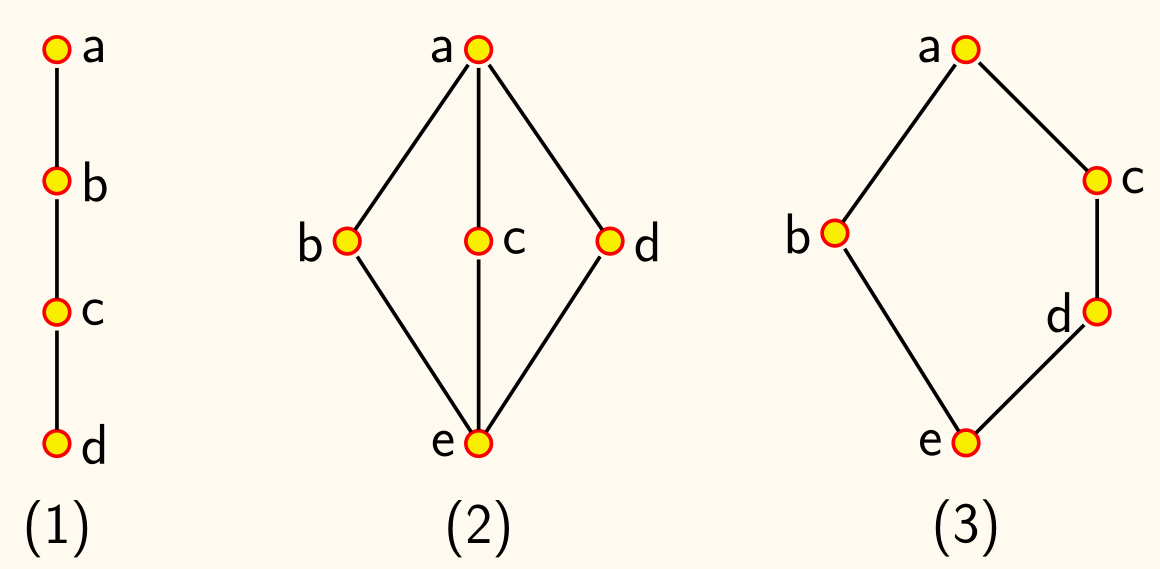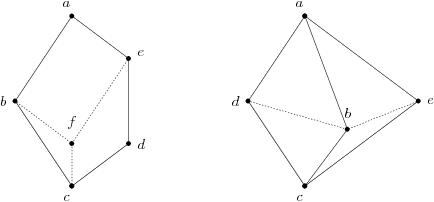概念
设 (L,≼) 是偏序集,若
- 对任意 x,y∈L,存在 {x,y} 最小上界 lub{x,y},记为 x∨y,也称为 x 和 y 的并(join);
- 对任意 x,y∈L,存在 {x,y} 最大下界 glb{x,y},记为 x∧y,也称为 x 和 y 的交(meet)。
则称 L 关于 ≼ 构成一个格(lattice)。
性质
- a≼b,b≼c⟹a∨b≼c
- c≼a,c≼b⟹c≼a∧b
- a≼c,b≼d⟹a∨b≼c∨d,a∧b≼c∧d
若 (L,≼) 是格,则 ∀a,b∈L,有:
a≼b⟺a∧b=a⟺a∨b=b
设 (L,≼) 是格,则 ∨,∧ 可看作是 L 上的二元运算,有如下性质:
- 结合律:(a∧b)∧c=a∧(b∧c),(a∨b)∨c=a∨(b∨c);
- 交换律:a∧b=b∧a,a∨b=b∨a;
- 吸收律:a∧(a∨b)=a,a∨(a∧b)=a;
- 幂等律:a∧a=a,a∨a=a;
对偶命题
设 P 是含有格中元素及符号 =,≼,≽,∨,∧ 的命题。则将 P 中
- ≼ 替换为 ≽
- ≽ 替换为 ≼
- ∨ 替换为 ∧
- ∧ 替换为 ∨
所得到的命题称为 P 的对偶命题 P∗。
格的对偶定理
若命题 P 对一切格成立,则 P∗ 也对一切格成立。
证明
定义 S 上二元关系 ≼∗:∀a,b∈S,a≼∗b⟺b≼a,显然 ≼∗ 是 S 上的偏序关系。
而 ∀a,b∈S,a∧∗b=a∨b,a∨∗b=a∧b,故 S 关于 ≼∗ 构成一个格。
从而 P∗ 在 (S,≼) 中为真当且仅当 P 在 (S,≼∗) 中为真。
而 P 对一切格成立,故 P∗ 对一切格成立。
代数格
格的代数性质:
- 结合律
- 交换律
- 吸收律(吸收律蕴含幂等律,如 x∧x=x∧(x∨(x∧x))=x)
设 L 是一个集合,∧,∨ 是 L 上的二元运算,且满足结合律、交换律、吸收律,则 (L,∧,∨) 构成一个代数格。
对代数格 (L,∧,∨),有:
- ∀x,y∈L,x∧y=x⟺x∨y=y
- ∀x,y∈L,定义 x≼y⟺x∧y=x,则 (L,≼) 是一个(偏序)格。
- lub{x,y}=x∨y
- glb{x,y}=x∧y
子格
设 (L,∧,∨) 是代数格,非空集合 S⊆L,若 S 关于 ∧,∨ 构成一个格,则称 (S,∧,∨) 是 L 的一个子格。
设 L 为如图所示的格,设
S1S2={a,e,f,g}={a,b,e,g}
flowchart TB
g --- e & f --- c
e --- b --- a
c --- a
f --- d --- a
则 S1 不是 L 的子格,因为 e∧f=c∈/S1。
S2 是 L 的子格。
格同态
设 (L1,∧1,∨1) 和 (L2,∧2,∨2) 是代数格,若有函数 f:L1→L2 使得任意 a,b∈L1,都有
f(a∧1b)f(a∨1b)=f(a)∧2f(b)=f(a)∨2f(b)
成立。则称 f 是从 L1 到 L2 的同态映射,简称格同态。
格同态保序:∀x,y∈L1,(x≼1y→f(x)≼2f(y))。一般逆命题不成立,如下所示。
flowchart LR
subgraph 11[ ]
direction TB
1' & u' & 0'
end
subgraph 22[ ]
direction LR
u & 1 & 0 & v
end
u --- 0 & 1 --- v
1 -.-> 1'
0 -.-> 0'
u & v -.-> u'
格同构
设 (L1,∧1,∨1) 和 (L2,∧2,∨2) 是代数格,且其同态映射 f 为双射,则称 f 是从 L1 到 L2 的同构映射,简称格同构。
若 f 为 L1 到 L2 的双射,则 f 为格同构当且仅当
∀x,y∈L1,(x≼1y↔f(x)≼2f(y))
证明
充分性:
由于 x∧1y≼1x,由保序性,f(x∧1y)≼2f(x);同理,f(x∧1y)≼2f(y);于是 f(x∧1y)≼2f(x)∧2f(y)。
由于逆映射 f−1 仍然保序,f(x)∧2f(y)≼2f(x),f−1(f(x)∧2f(y))≼1x;同理 f−1(f(x)∧2f(y))≼1y;于是 f−1(f(x)∧2f(y))≼1x∧1y;再由 f 保序,f(x)∧2f(y)= f(f−1(f(x)∧2f(y)))≼2f(x∧1y)。
于是 f(x∧1y)=f(x)∧2f(y)。同理可证 f(x∨1y)=f(x)∨2f(y)。
必要性由上面格同态保序的结论可知。
同构的格具有相同的哈斯图形状。
下图分别为链(chain)、钻石格 M3(diamond lattice)、和五角格 N5(pentagon lattice)的哈斯图:

分配格
设 (L,∧,∨) 为格,若 ∀a,b,c∈L,有
- a∧(b∨c)=(a∧b)∨(a∧c)
- a∨(b∧c)=(a∨b)∧(a∨c)
则称 (L,∧,∨) 为分配格(distributive lattice)。
flowchart TB
subgraph 1[ ]
direction TB
1a[a] --- 1b[b] & 1c[c] & 1d[d] --- 1e[e]
end
subgraph 2[ ]
direction TB
2a[a] --- 2b[b] & 2c[c]
2c --- 2d[d]
2b & 2d --- 2e[e]
end
钻石格 M3 与五角格 N5 不是分配格。
- M3:b∧(c∨d)=b 而 (b∧c)∨(b∧d)=e
- N5:d∨(b∧c)=d 而 (d∨b)∧(d∨c)=c
分配格判定定理一
设 L 为格,则 L 是分配格当且仅当 L 不含有与 M3 或 N5 同构的子格。
从而有推论:

有 M3 或 N5 作为子集,但不是子格,未必不是分配格。如上图两个格都是分配格。
分配格判定定理二
设 L 为格,则 L 是分配格当且仅当对于任意 a,b,c∈L,有
(a∧b=a∧c)∧(a∨b=a∨c)→b=c
证明
必要性:
b=b∨(a∧b)=b∨(a∧c)=(b∨a)∧(b∨c)=(a∨c)∧(b∨c)=(a∧b)∨c=(a∧c)∨c=c
有界格
设 L 为格,若
- ∃b∈L,∀x∈L,b≼x,则 b 称为格 L 的全下界(bottom),记作 0。
- ∃t∈L,∀x∈L,x≼t,则 t 称为格 L 的全上界(top),记作 1。
设 L 为格,若 L 有全下界和全上界,则称 L 为有界格(bounded lattice)。
全上界和全下界存在必唯一。
有界格一般记为 (L,∧,∨,0,1)。
-
∀a∈L,a∨0=a,a∧1=a
-
同一律:∀a∈L,a∨0=a,a∧1=a
-
支配律:∀a∈L,a∧0=0,a∨1=1
因此称
- 0 是关于 ∨ 的单位元,关于 ∧ 的零元
- 1 是关于 ∧ 的单位元,关于 ∨ 的零元
有限格 L={a1,⋯,an} 为有界格,且
- 0=a1∧⋯∧an
- 1=a1∨⋯∨an
求涉及有界格的命题之对偶命题,须将全下界与全上界对换。
补元
设 (L,∧,∨,0,1) 为有界格,若对 a∈L,存在 b∈L,使得
- a∧b=0
- a∨b=1
则称 b 为 a 的补元(complement)。
- 有界格中 0 和 1 互为补元
- 补元可能不存在
- 补元若存在,未必唯一
有界分配格补元唯一
设 (L,∧,∨,0,1) 为有界分配格,a∈L 的补元若存在,则唯一。
证明
假设 b 和 c 是 a 的补元,则
a∨c=1,a∧c=0a∨b=1,a∧b=0
由于全上界和全下界的唯一性,有 a∨c=a∨b,a∧c=a∧b,由于 L 为分配格,有 b=c。
设 (L,∧,∨,0,1) 为有界格,若 L 中每个元素都有补元,则称 L 为有补格(complemented lattice)。
M3 与 N5 皆为有补格。
有补分配格性质:
- 代数格:结合律、交换律、吸收率、(幂等律)
- 分配格:分配律
- 有界:同一律、(支配律)
- 有补:补律、(双重补律、德摩根律)
有补分配格的代数性质 ⟹ 布尔代数。


